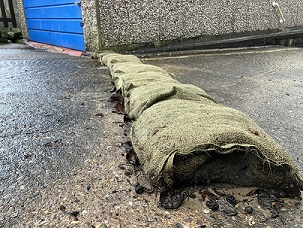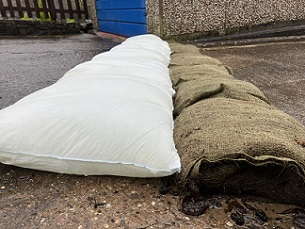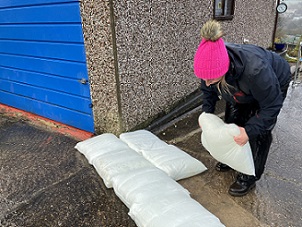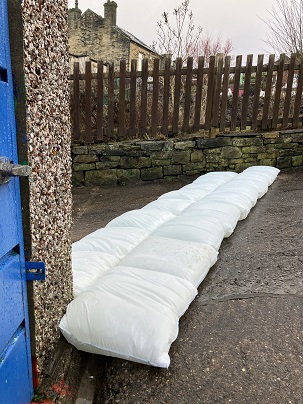 The line of rotting sandbags that were allowing floodwater to get into a pensioner's home
The line of rotting sandbags that were allowing floodwater to get into a pensioner's home
 See the difference with a single line of FloodSax next to the decaying sandbags
See the difference with a single line of FloodSax next to the decaying sandbags
 Lucy Bailey from FloodSax deploying the alternative sandbags
Lucy Bailey from FloodSax deploying the alternative sandbags
 The double line of FloodSax is complete and the house is protected from flooding
The double line of FloodSax is complete and the house is protected from flooding
Traditional sandbags rot and fail to protect pensioner’s home from flooding but FloodSax save the day
Sandbags will let you down in a flooding emergency which is just what happened to a pensioner in Yorkshire.
She had a row of sandbags to try to divert water from pouring down her driveway and into her home in Huddersfield.
But she called in FloodSax when they weren’t working and had started to rot. We were quickly on the scene to provide her with two rows of FloodSax alternative sandbags to make sure the water wouldn’t get through. Instead, it was diverted into a drainage channel in front of her garage and away from her house.
Lucy Bailey from Environmental Defence Systems Ltd, which devised and manufactures FloodSax, said: “The sandbags were very poor, falling apart and failing to stop the water. We even put a row of FloodSax next to them to show the difference. FloodSax are larger, wider, have a more uniform shape and way more robust at diverting water. They won’t rot either.
“It was important to act quickly as the water was cascading down her steep drive and straight into her house.”
It just goes to prove once more that people need to stop thinking about sandbags when they are at risk of flooding.
They are expensive, very few companies sell them prefilled, they are very heavy and unwieldy to move and stack, quickly rot when they come into contact with floodwater and spill sand all over the place which makes them very environmentally unfriendly. The sand can get down drains, clogging them up and leading to more flooding.
Some local councils have now ‘banned the bag’ and won’t have anything to do with old-style sandbags. Councils have no responsibility to provide sandbags or any other flood protection devices.
FloodSax come vacuum-packed in packs of five so are exceptionally space-saving to store. To transform them into instant sandless sandbags, simply immerse them in water and the gelling polymer inside the FloodSax absorbs the water and retains it. The bag then grows in size until it becomes a 20kg ‘sandbag’ but without any sand. They are 96% biodegradable by weight so can be thrown in landfill after they’ve been used.
They are multi-purpose and flexible. In their dry state they are very flat with a large surface area so can be used to absorb leaks, drips, spills and floods inside homes and businesses, often in hard-to-reach places such as beneath floorboards and under boilers.
FloodSax cost around £140 for 20 – that price can even include next day delivery - which is good value for money compared to sandbags which cost up to £370 for 70 prefilled with sand and delivery can often take between 7 and 10 days.
One company which sells them even warns: “Hessian sandbags should be used within four weeks of purchase due to biodegrading as soon as they get wet.”
Also be aware that a lot of the pre-filled sandbags are way smaller than Floodsax, weighing just 15kg, so you need a lot more to build them into a flood barrier and they are more difficult to stack.
FloodSax are larger at 20kg, exceptionally robust and will keep their shape for two or three months. They have a guaranteed shelf-life of at least 5 years before they are used due to the high quality of their vacuum-packing.
People can, of course, buy sandbag covers and the sand separately and then fill the sandbags themselves but it’s a terrible hassle, they need to make sure they have bought the right kind of sand and then there is still the problem of storage with the sandbags quickly deteriorating, especially when wet.
For more information on FloodSax, including customer testimonials, go to www.floodsax.co.uk